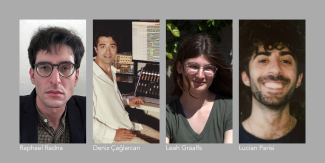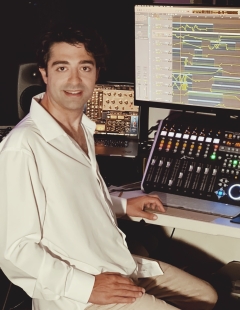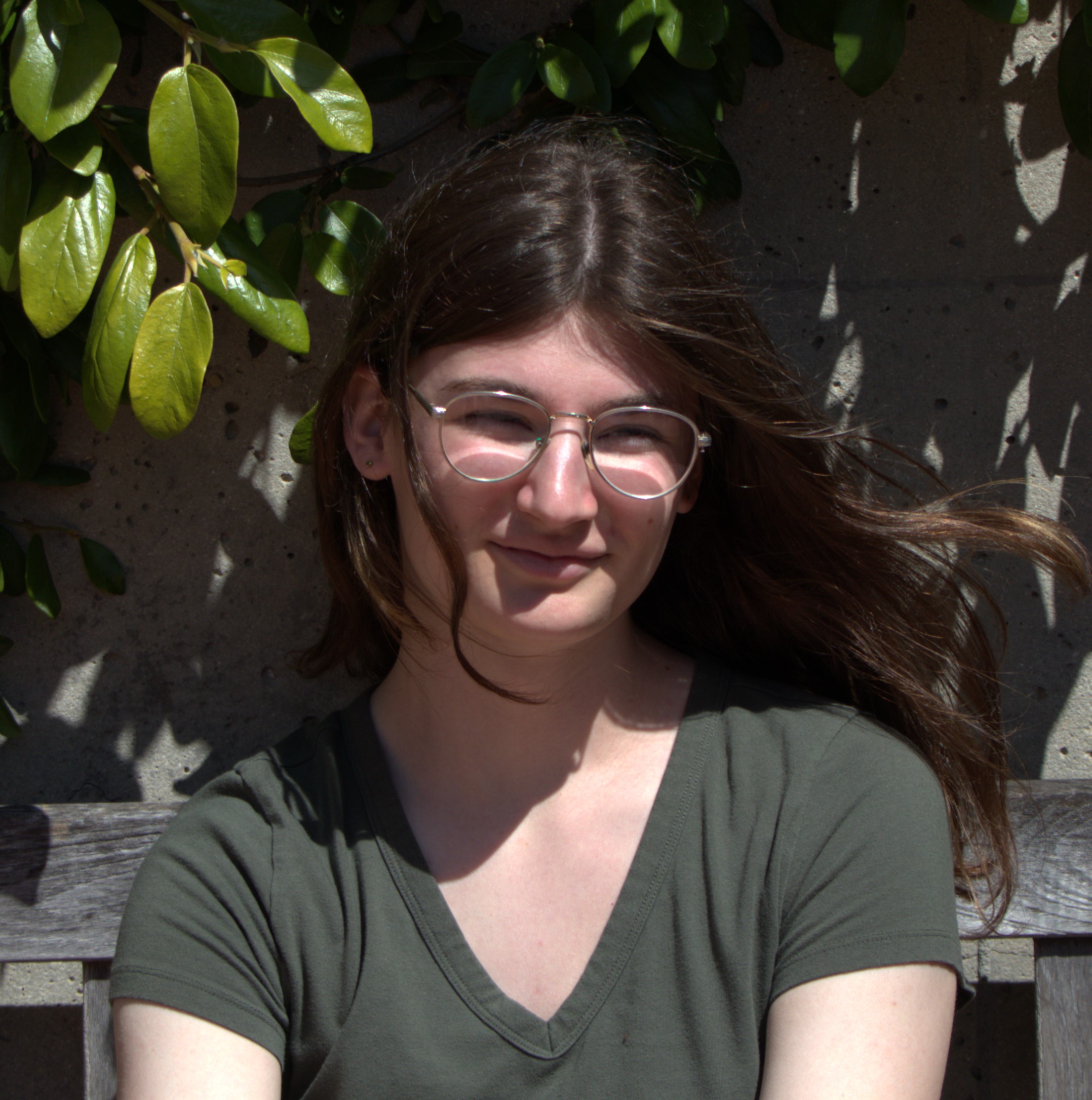Announcing the 2024 Dorothy and Sherrill C. Corwin Awards Winners

Media Contact
Alessandra Villegas
Marketing and Communications Manager
a_villegas@ucsb.edu
June 3, 2024
Hosted annually by the UC Santa Barbara Department of Music, the Dorothy and Sherrill C. Corwin Awards recognize excellence in Music Composition, and are open to all UC Santa Barbara undergraduate and graduate student music majors in the Department of Music, the College of Creative Studies, and the Media Arts and Technology Program. The 2024 Awards included three categories: Work for Large Ensemble, Work for Chamber Ensemble, and Electronic/Audio-visual Work.
Every year, three external judges are nominated by the Corwin Chair to evaluate student scores and recordings and award prizes linked to monetary rewards, concert performances, and studio recordings. Nominated by Corwin Chair of Composition João Pedro Oliveira, this year’s jury included Katherine Balch from Yale University, Rodolfo Souza from Sao Paulo University, and Mikel Kuehn from Eastman School of Music. Read on to learn more about each of the 2024 Awardees and their works.
The Dorothy and Sherrill C. Corwin Awards are generously supported by the Corwin Family Foundation.
Graduate Student Awards:
Category 1: No prize
Category 2: Prize: Raphael Radna - "Kohelet"
Category 3: Prize: Deniz Çağlarcan - "Shadows"
Undergraduate Student Awards:
Category 1: No prize
Category 2: Prize: Leah Graalfs - "Across Worlds"
Category 3: Prize: Lucian Parisi - "foam, resin"
About the Composers & Works

Raphael Radna - "Kohelet"
Raphael Radna is a composer and computer music researcher working in acousmatic music, mixed music, computer-assisted composition, spatial audio, and creative music software development. He has presented music and research worldwide in such venues as the International Computer Music Conference, the Digital Audio FX Conference, the SEAMUS National Conference, the New York City Electroacoustic Music Festival, and the Visiones Sonoras Festival of Music and New Technologies; and has collaborated with such artists as Erin McKibben, Antonina Styczeń, Shanna Pranaitis, HOCKET, and the Isaura String Quartet. His music technology work includes the Space Control spatialization software, the Xenos stochastic synthesizer, and projects for prominent developers Arturia and Cycling ‘74. His chapter on Xenos will appear in the forthcoming volume “Meta-Xenakis: New Perspectives on Iannis Xenakis’s Life, Work, and Legacies” from Open Book Publishers. Raphael holds a BA in Music from Vassar College, an MFA in Electronic Music and Recording Media from Mills College, and an MS in Media Arts and Technology from UC Santa Barbara, where he is currently a PhD candidate in Music Composition. He has had the privilege of studying with João Pedro Oliveira, Curtis Roads, and Clarence Barlow during his time at UCSB.
Kohelet, for clarinet, piano, cello and electronics
“Kohelet” is a book in the Ketuvim (“Writings”) of the Hebrew Bible. In this text, the mysterious Kohelet ruminates on the paradoxical search for meaning in a life that we know must end. “Havel havalim, hakol havel,” Kohelet’s insistent refrain: “Everything is vapor!”
I composed this work during a period of great upheaval in my life. I found myself returning time and again to the ancient words of Kohelet in my own contemplation of the nature of meaning: in duty, devotion, suffering, and loss; in oneness, twoness, passion, and progeny; in perseverance, achievement, fulfillment, and destiny—and also in the creation and enjoyment of music.
There are many ways we might respond when faced with our own transience. We can become agitated or indignant; we can become afraid; we can despair, become despondent; we can succumb to denial and struggle against our fate; or we can submit to our inherent meaninglessness and perhaps find liberation therein. “To everything, there is a season,” teaches immortal Kohelet; all of these moods—and perhaps others—are reflected in this work.

Deniz Çağlarcan - "Shadows"
Deniz Çağlarcan is a Los Angeles-based composer, violist, and conductor initially from Istanbul, Turkey. He investigates the sonic quality of electronic music by any means and realizes this idealized environment as a model for his musical language. Çağlarcan’s music explores the interaction between acoustic instruments and electronic sounds within their sonic morphology. Besides, he is intrigued to create an environment by utilizing various immersive audio techniques as well as visuals and spatial elements that surround the audience. He performs interdisciplinary works collaborating with media artists, computer graphics developers, and machine learning engineers. His works include solo instrumental pieces, chamber music, large ensembles, tape/electroacoustic works, live-electronic, mixed works, audio/visual compositions, site-specific sound installations, arrangements as well as film and video games scores.
Besides his composition career as a violist, he performs in solo concerts, chamber music, new music ensembles, and popular music. He is also co-founder of the ADE Duo ensemble. He studied orchestral conducting for over eight years, and at Central Michigan University, he continued very in-depth study with José-Luis Maúrtua. He holds degrees in Master of Music in Viola Performance from Central Michigan University and a Master of Arts in Composition from Bilkent University. Çağlarcan is currently a Ph.D. student in Composition studying with João Pedro Oliveira and Master of Science in Media Arts and Technology with Curtis Roads at the University of California, Santa Barbara. He has studied with notable composers and performers; Mark Andre, Beat Furrer, Tolga Yayalar, Bruno Mantovani, Ken Ueno, Pierluigi Billone, Clara Iannotta, Alberto Posadas, Isabel Mundry, Ulrich Kreppein, Laura San Martin, Jay C. Batzner, Alicia Valoti, Sheila Browne, Scott Woolweaver, Yuri Gandelsman, Tatjana Masurenko, Walter Küssner, Hartmut Rohde, Alexander Zemtsov, Ulrich Mertin, Christine Ruthledge.

Leah Graalfs - "Across Worlds"
Leah Graalfs is a student at UCSB studying Music Composition with the College of Creative Studies. She is a pianist and percussionist, with a background in jazz, and she often features these instruments when writing chamber and concert works. She aspires to compose video game soundtracks, with some of her inspirations being composers Lena Raine and Koji Kondo. In her spare time she loves to crochet and, of course, play video games, especially old Nintendo and indie games.
This piece explores distinct “worlds” of sound, drawing on the inspiration of being in a unique new environment during my first year at UCSB. The distinguishable sections of the piece resemble different experiences and the emotions that come along with them. The interplay across the marimba and vibraphone represents the connection between my hometown and UCSB, sometimes in stark contrast, sometimes in serene harmony. The development later into the composition reflects the expansion of my worldview that comes along with learning to adjust to a completely new set of life experiences — new people, new sounds, new emotions, not without their deep lows as well as soaring highs — a whole new world.
Lucian Parisi - "foam, resin"
Lucian Parisi is a granular chamber composer, ethereal art-rock producer, and audio engineer. The California-based multi-instrumentalist creates psychedelic mixed-media experiences and environmental art. He is currently finishing a B.A. in Music Composition at UCSB's College of Creative Studies, before starting his M.S. in Media Arts and Technology at UCSB - researching ecological acoustics and digital signal processing for spatial audio.
"foam, resin" is a study of materials via treated guitars (foam, plate, bowed), violin, and resonating objects. Sonically, this piece strives to capture the essence of liquid foam and dry, abrasive resin. To explore this juxtaposition, the performer is provided with a piece of graphic notation - open to interpretation. The graphic notation is constructed of physical materials that reflect its auditory counterparts. This helps differentiate instrumental voices in the piece, as well as blur the line between physical and auditory mediums. The composition is primarily cell based, evolving around a few primary string and guitar gestures as the textural density morphs. All sounds are derived from listed instrumentation, with restraint exercised in post-production. The piece is meant to be consumed as an audio-visual experience.
Congratulations to the 2024 Corwin Award Winners!
Read More
Latest News